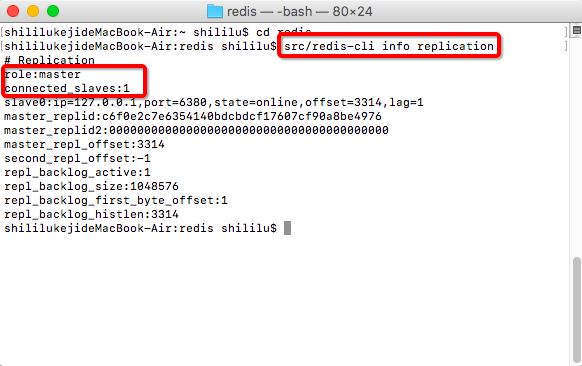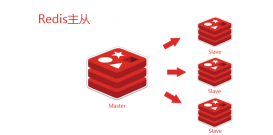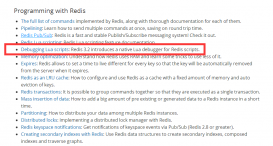本文主要为大家介绍缓存技术中的一种Redis的安装和使用,供大家参考,具体内容如下
一、下载Redis for windows
在网络中搜索Redis fow windows,就可以下载Redis的压缩包。解压包。

会发现其中有32位和64位的不同版本的包,根据需要,使用对应的压缩包即可。
二、解压
我使用的是redisbin_x64.zip的压缩包,将其解压到redis的文件夹中。
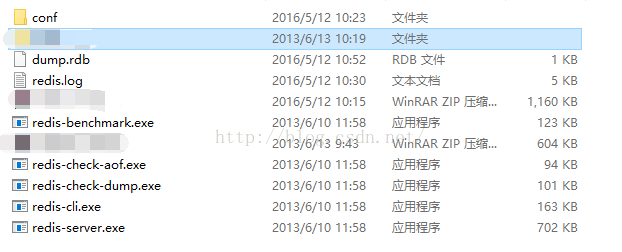
解压之后,会发现内容只有一些.exe的文件。到这里,redis就算做好了一半了。
三、配置
在redis下新建一个conf的文件夹,并创建 redis.conf 文本文件。将一下内容复制到配置文件中。
- # Redis configuration file example
- # By default Redis does not run as a daemon. Use 'yes' if you need it.
- # Note that Redis will write a pid file in /var/run/redis.pid when daemonized.
- # 是否以后台进程的形式运行,默认为no
- daemonize no
- # When run as a daemon, Redis write a pid file in /var/run/redis.pid by default.
- # You can specify a custom pid file location here.
- # 如果指定以后台形式执行,则需要指定一个pid文件
- pidfile /var/run/redis.pid
- # Accept connections on the specified port, default is 6379
- #监听端口号
- port 6379
- # If you want you can bind a single interface, if the bind option is not
- # specified all the interfaces will listen for connections.
- # 绑定主机IP
- # bind 127.0.0.1
- # Close the connection after a client is idle for N seconds (0 to disable)
- # 客户端空闲超时时间,设置为0,则没有超时。过了空闲时间,则会将客户端的连接关闭
- timeout 300
- # Set server verbosity to 'debug'
- # it can be one of:
- # debug (a lot of information, useful for development/testing)
- # notice (moderately verbose, what you want in production probably)
- # warning (only very important / critical messages are logged)
- # 日志记录等级
- loglevel debug
- # Specify the log file name. Also 'stdout' can be used to force
- # the demon to log on the standard output. Note that if you use standard
- # output for logging but daemonize, logs will be sent to /dev/null
- # 日志记录方式
- logfile stdout
- # Set the number of databases. The default database is DB 0, you can select
- # a different one on a per-connection basis using SELECT <dbid> where
- # dbid is a number between 0 and 'databases'-1
- # 可用数据库数目
- databases 16
- ################################ SNAPSHOTTING #################################
- #
- # Save the DB on disk:
- #
- # save <seconds> <changes>
- #
- # Will save the DB if both the given number of seconds and the given
- # number of write operations against the DB occurred.
- #
- # In the example below the behaviour will be to save:
- # after 900 sec (15 min) if at least 1 key changed
- # after 300 sec (5 min) if at least 10 keys changed
- # after 60 sec if at least 10000 keys changed
- save 900 1
- save 300 10
- save 60 10000
- # Compress string objects using LZF when dump .rdb databases?
- # For default that's set to 'yes' as it's almost always a win.
- # If you want to save some CPU in the saving child set it to 'no' but
- # the dataset will likely be bigger if you have compressible values or keys.
- # 存储到本地数据库时,是否需要压缩数据
- rdbcompression yes
- # The filename where to dump the DB
- #本地数据名称
- dbfilename dump.rdb
- # For default save/load DB in/from the working directory
- # Note that you must specify a directory not a file name.
- # 本地数据库存放路径
- dir ./
- ################################# REPLICATION #################################
- # Master-Slave replication. Use slaveof to make a Redis instance a copy of
- # another Redis server. Note that the configuration is local to the slave
- # so for example it is possible to configure the slave to save the DB with a
- # different interval, or to listen to another port, and so on.
- # 当该服务为从服务时,设置主服务的ip地址和端口号
- #
- # slaveof <masterip> <masterport>
- # If the master is password protected (using the "requirepass" configuration
- # directive below) it is possible to tell the slave to authenticate before
- # starting the replication synchronization process, otherwise the master will
- # refuse the slave request.
- # 当该服务为从服务时,设置主服务的连接密码
- #
- # masterauth <master-password>
- ################################## SECURITY ###################################
- # Require clients to issue AUTH <PASSWORD> before processing any other
- # commands. This might be useful in environments in which you do not trust
- # others with access to the host running redis-server.
- #
- # This should stay commented out for backward compatibility and because most
- # people do not need auth (e.g. they run their own servers).
- # 连接密码
- #
- # requirepass foobared
- ################################### LIMITS ####################################
- # Set the max number of connected clients at the same time. By default there
- # is no limit, and it's up to the number of file descriptors the Redis process
- # is able to open. The special value '0' means no limts.
- # Once the limit is reached Redis will close all the new connections sending
- # an error 'max number of clients reached'.
- # 最大客户端连接数,默认不设置
- #
- # maxclients 128
- # Don't use more memory than the specified amount of bytes.
- # When the memory limit is reached Redis will try to remove keys with an
- # EXPIRE set. It will try to start freeing keys that are going to expire
- # in little time and preserve keys with a longer time to live.
- # Redis will also try to remove objects from free lists if possible.
- #
- # If all this fails, Redis will start to reply with errors to commands
- # that will use more memory, like SET, LPUSH, and so on, and will continue
- # to reply to most read-only commands like GET.
- #
- # WARNING: maxmemory can be a good idea mainly if you want to use Redis as a
- # 'state' server or cache, not as a real DB. When Redis is used as a real
- # database the memory usage will grow over the weeks, it will be obvious if
- # it is going to use too much memory in the long run, and you'll have the time
- # to upgrade. With maxmemory after the limit is reached you'll start to get
- # errors for write operations, and this may even lead to DB inconsistency.
- # 设置最大内存,达到最大内存设置后,Redis线尝试清楚已到期或即将到期的key,当此方法处理后,达到最大内存设置,将不能在进行写入操作。
- #
- # maxmemory <bytes>
- ############################## APPEND ONLY MODE ###############################
- # By default Redis asynchronously dumps the dataset on disk. If you can live
- # with the idea that the latest records will be lost if something like a crash
- # happens this is the preferred way to run Redis. If instead you care a lot
- # about your data and don't want to that a single record can get lost you should
- # enable the append only mode: when this mode is enabled Redis will append
- # every write operation received in the file appendonly.log. This file will
- # be read on startup in order to rebuild the full dataset in memory.
- #
- # Note that you can have both the async dumps and the append only file if you
- # like (you have to comment the "save" statements above to disable the dumps).
- # Still if append only mode is enabled Redis will load the data from the
- # log file at startup ignoring the dump.rdb file.
- #
- # The name of the append only file is "appendonly.log"
- #
- # IMPORTANT: Check the BGREWRITEAOF to check how to rewrite the append
- # log file in background when it gets too big.
- # 设置Redis服务器在每次操作完成后,是否更新日志操作,如果关闭,可能会在断电时导致一段时间内的数据丢失,
- # 因为Redis本身同步数据文件是按照上面的save条件来同步的,所以有的数据会在一段时间内存储于内存中。
- appendonly no
- # 更新日志文件名
- # appendfilename appendonly.aof
- # The fsync() call tells the Operating System to actually write data on disk
- # instead to wait for more data in the output buffer. Some OS will really flush
- # data on disk, some other OS will just try to do it ASAP.
- #
- # Redis supports three different modes:
- #
- # no: don't fsync, just let the OS flush the data when it wants. Faster.
- # always: fsync after every write to the append only log . Slow, Safest.
- # everysec: fsync only if one second passed since the last fsync. Compromise.
- #
- # The default is "always" that's the safer of the options. It's up to you to
- # understand if you can relax this to "everysec" that will fsync every second
- # or to "no" that will let the operating system flush the output buffer when
- # it want, for better performances (but if you can live with the idea of
- # some data loss consider the default persistence mode that's snapshotting).
- # 更新日志条件,有三个可选值:
- appendfsync always
- # appendfsync everysec
- # appendfsync no
- ############################### ADVANCED CONFIG ###############################
- # Glue small output buffers together in order to send small replies in a
- # single TCP packet. Uses a bit more CPU but most of the times it is a win
- # in terms of number of queries per second. Use 'yes' if unsure.
- #glueoutputbuf yes
- # Use object sharing. Can save a lot of memory if you have many common
- # string in your dataset, but performs lookups against the shared objects
- # pool so it uses more CPU and can be a bit slower. Usually it's a good
- # idea.
- #
- # When object sharing is enabled (shareobjects yes) you can use
- # shareobjectspoolsize to control the size of the pool used in order to try
- # object sharing. A bigger pool size will lead to better sharing capabilities.
- # In general you want this value to be at least the double of the number of
- # very common strings you have in your dataset.
- #
- # WARNING: object sharing is experimental, don't enable this feature
- # in production before of Redis 1.0-stable. Still please try this feature in
- # your development environment so that we can test it better.
- # shareobjects no
- # shareobjectspoolsize 1024
- # 是否使用虚拟内存
- #vm-enabled no;
- # 虚拟内存文件路径,不能多个redis共享
- # vm-swap-file /tmp/redis.swap
- # 将所有大于vm-max-memory 的数据存入虚拟内存。无论vm-max-memory值大小,所有的索引数据都是内存数据。
- # 如果将vm-max-memory设置为0,则所有的数据都存放在磁盘。
- # vm-max-memory 0
四、启动redis服务器
使用一下命令启动 redis服务器。
redis-server.exe conf/redis.conf
启动成功之后,你会看到如下的提示:
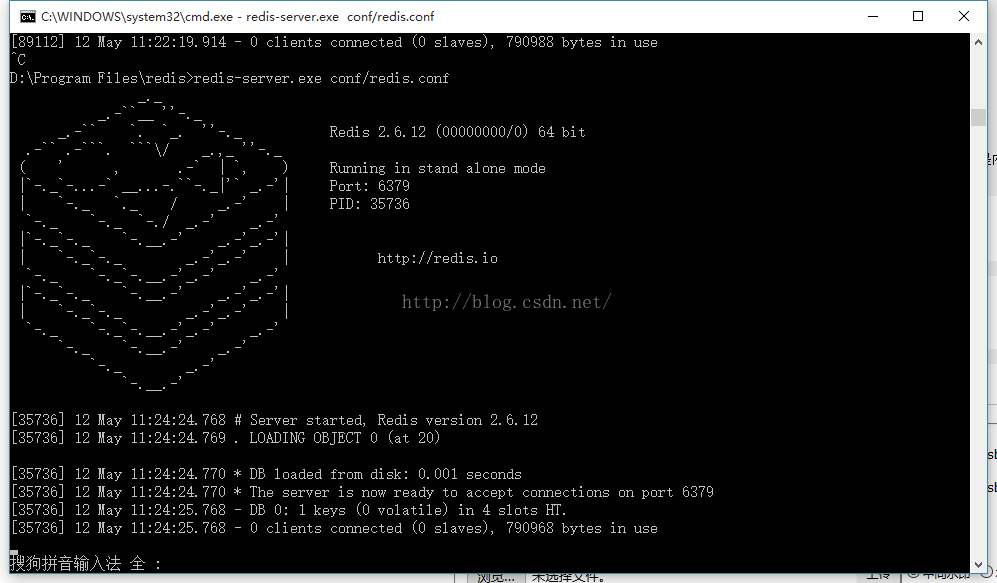
五、连接redis服务器
使用redis自带的命令,能够连接服务器。
redis-cli.exe -h localhost -p 6379
连接成功之后,会提示以下内容:

这个时候,你就能够使用redis的一下指令操作数据。其他指令,请在网上具体查看一下。
以上就是本文的全部内容,希望对大家的学习有所帮助。

